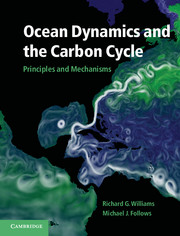Book contents
- Frontmatter
- Contents
- Preface
- Acknowledgements
- Illustration credits
- Part I Introduction
- Part II Fundamentals
- Part III Physical Phenomena and their Biogeochemical Signals
- 7 Seasonality of the upper ocean
- 8 Ocean gyres and intense currents
- 9 Ocean eddies
- 10 Ventilation
- 11 Cycling and transport of nutrients and carbon
- 12 The deep ocean and overturning
- Part IV Synthesis
- Appendix
- Symbols and definitions
- Glossary
- Answers
- References
- Index
- Plate section
7 - Seasonality of the upper ocean
from Part III - Physical Phenomena and their Biogeochemical Signals
Published online by Cambridge University Press: 05 June 2012
- Frontmatter
- Contents
- Preface
- Acknowledgements
- Illustration credits
- Part I Introduction
- Part II Fundamentals
- Part III Physical Phenomena and their Biogeochemical Signals
- 7 Seasonality of the upper ocean
- 8 Ocean gyres and intense currents
- 9 Ocean eddies
- 10 Ventilation
- 11 Cycling and transport of nutrients and carbon
- 12 The deep ocean and overturning
- Part IV Synthesis
- Appendix
- Symbols and definitions
- Glossary
- Answers
- References
- Index
- Plate section
Summary
One of the most striking features on the planet is the seasonal variation in sunlight, longer days in summer and shorter days in winter outside the tropics, as marked by the spring unfolding of leaves and their later autumn colour change and fall. Seasonal changes in sunlight likewise affect the upper ocean. Surface waters warm in summer and cool in winter, reaching their highest and lowest temperatures close to the autumn and spring equinoxes, respectively, as illustrated in Fig. 7.1a.
The marine ecosystem also responds to the progression of the seasons, affected by variations in sunshine and the availability of nutrients in surface waters. There are, however, some surprises. At high latitudes, phytoplankton bloom in summer when daylight is greatest, while at mid latitudes they flourish in winter or spring when nutrients are most plentiful. During summer, phytoplankton concentrations diminish in the subtropics and tropics near the surface and instead become more abundant at depths of 100m where sunlight penetrates weakly, but there are nutrient-rich waters (Fig. 7.1b).
In turn, these physical and biological changes affect the carbon cycle: seasonal warming and cooling drive an ocean outgassing of carbon dioxide in summer and an uptake in winter; while seasonal growth of phytoplankton drives a consumption of dissolved inorganic carbon in surface waters, often leading to an ocean uptake of carbon dioxide and, conversely, a later decay of organic matter leads to the reverse process and an outgassing of carbon dioxide.
- Type
- Chapter
- Information
- Ocean Dynamics and the Carbon CyclePrinciples and Mechanisms, pp. 159 - 182Publisher: Cambridge University PressPrint publication year: 2011



